The AMD Ryzen Threadripper 3960X and 3970X Review: 24 and 32 Cores on 7nm
by Dr. Ian Cutress, Andrei Frumusanu & Gavin Bonshor on November 25, 2019 9:05 AM ESTGaming: Grand Theft Auto V
The highly anticipated iteration of the Grand Theft Auto franchise hit the shelves on April 14th 2015, with both AMD and NVIDIA in tow to help optimize the title. GTA doesn’t provide graphical presets, but opens up the options to users and extends the boundaries by pushing even the hardest systems to the limit using Rockstar’s Advanced Game Engine under DirectX 11. Whether the user is flying high in the mountains with long draw distances or dealing with assorted trash in the city, when cranked up to maximum it creates stunning visuals but hard work for both the CPU and the GPU.
For our test we have scripted a version of the in-game benchmark. The in-game benchmark consists of five scenarios: four short panning shots with varying lighting and weather effects, and a fifth action sequence that lasts around 90 seconds. We use only the final part of the benchmark, which combines a flight scene in a jet followed by an inner city drive-by through several intersections followed by ramming a tanker that explodes, causing other cars to explode as well. This is a mix of distance rendering followed by a detailed near-rendering action sequence, and the title thankfully spits out frame time data.
There are no presets for the graphics options on GTA, allowing the user to adjust options such as population density and distance scaling on sliders, but others such as texture/shadow/shader/water quality from Low to Very High. Other options include MSAA, soft shadows, post effects, shadow resolution and extended draw distance options. There is a handy option at the top which shows how much video memory the options are expected to consume, with obvious repercussions if a user requests more video memory than is present on the card (although there’s no obvious indication if you have a low end GPU with lots of GPU memory, like an R7 240 4GB).
All of our benchmark results can also be found in our benchmark engine, Bench.
| AnandTech | IGP | Low | Medium | High |
| Average FPS | 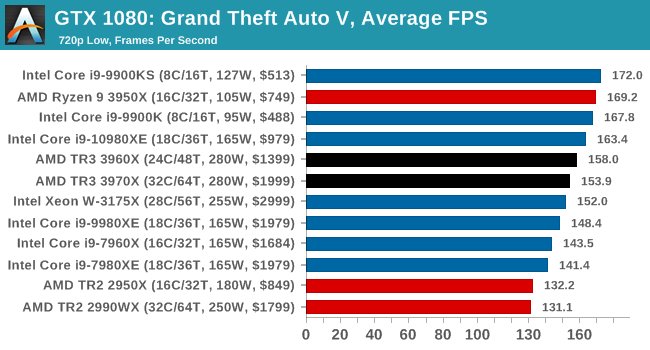 |
 |
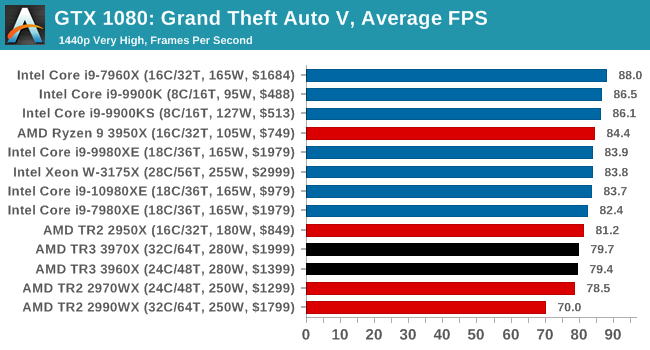 |
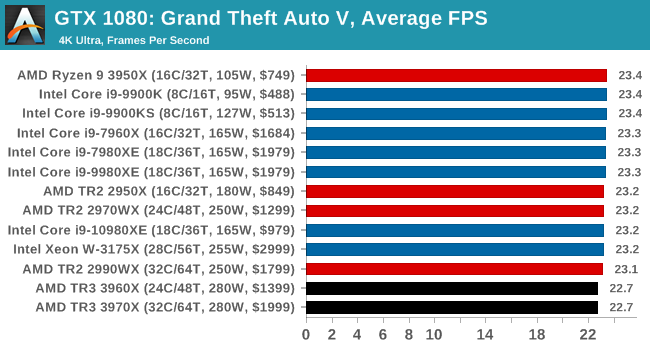 |
| 95th Percentile |  |
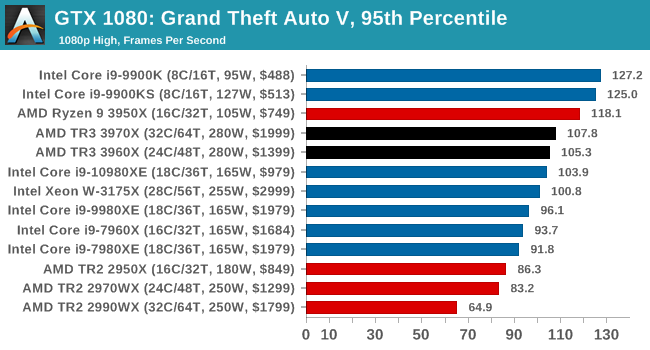 |
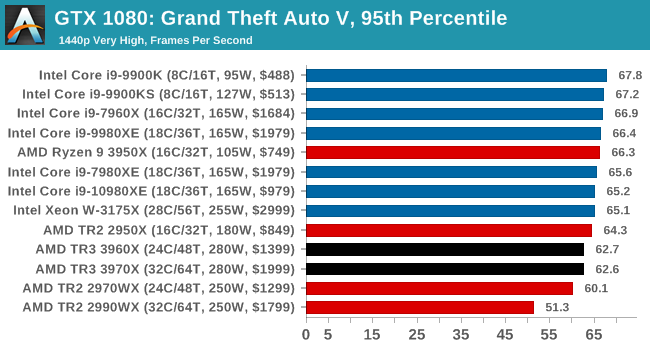 |
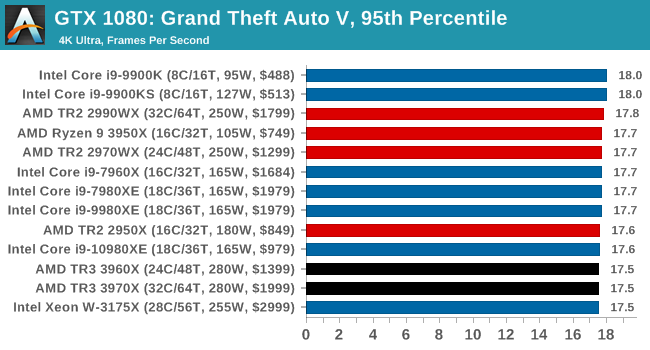 |


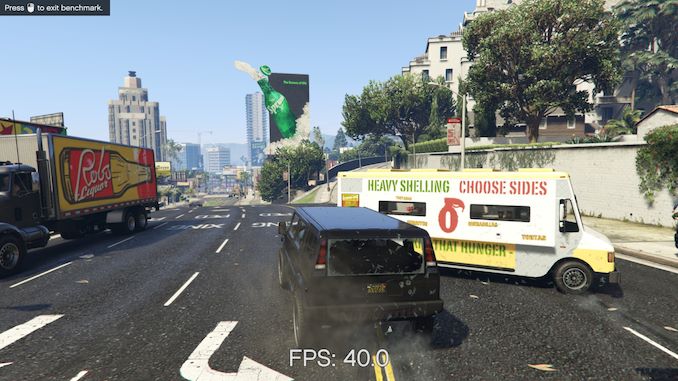









245 Comments
View All Comments
csutcliff - Monday, November 25, 2019 - link
RIP IntelNikosD - Monday, November 25, 2019 - link
It's a bloodpath.Threadrippers destroy even the Xeon W-3175X of 3000$.
Intel is having hard times, no doubt about it.
They look so incompetent nowadays.
melgross - Monday, November 25, 2019 - link
You guys are really funny. Intel had its best year yet, and will have an even better one next year.While you can hope that AMD will take the industry over, it’s never going to happen. We’ve seen that predicted in the past, and it isn’t any truer now.
Xyler94 - Monday, November 25, 2019 - link
The difference though, I don't think Intel can weasel their way through this storm as they did with the Athlon days.They didn't stay in the lead because people didn't want to buy AMD, they stayed because DELL and them were bribbed not to sell AMD, so your average consumer knew nothing about how much better the AMD platforms were.
Intel still holds the performance crown for laptops, which is arguably the bigger segment of the consumer market, but if they don't do something soon, AMD has the performance crown in HEDT and Servers now, both high margin areas, which Intel is super worried about.
Santoval - Monday, November 25, 2019 - link
Next year we will see Comet & Ice Lake based laptops compete with Zen 2 (+ Navi?) based laptops. Zen 2 based laptops will certainly surpass both in CPU performance, so the question is only if they'll be able to surpass the performance of the (Gen11) iGPU of Ice Lake. By that I mean only the parts with the 64 EUs of course, the Gen11 iGPUs with 24 and 48 EUs stand on chance.In any case, it appears that Comet Lake-U/Y will power the largest bulk of Intel's machines, machines with Ice Lake-U/Y will be released in low volume, and Ice Lake-U machines with 64 EU iGPUs will almost certainly be rarer than francium and more expensive than their weight in gold.
Santoval - Monday, November 25, 2019 - link
edit : "stand *no* chance".jabber - Tuesday, November 26, 2019 - link
Guys, some of you may not remember but we've been in this situation before.There was a time that Intel was king and could do no wrong. then about 16 years ago they could not do a thing right and everyone was AMD/SKT939 till the day they died. Ho ho ho!
Then AMD screwed up, Intel got it's act together and AMD was 'so over' etc. etc.
No doubt AMD will screw up again in a couple of years and Intel will get it together again...
Rinse and repeat. Just enjoy the ride.
xrror - Tuesday, November 26, 2019 - link
What really sucked was seeing AMD management at the time just sit there like a sitting duck. People playing with overclocking Pentium M on desktop boards demonstrated nearly a year before Conroe launched that if Intel developed their mobile design into a desktop chip that it would be a monster chip against A64.And Intel did just that.
That said, this time around... Sunny Cove had better start to scale clock wise, else it won't matter that it's 20% faster per clock if it can't actually reach 4Ghz.
It's going to be interesting.
DaBones - Wednesday, November 27, 2019 - link
A quick difference between then and now is that both companies are doing good things. Neither is releasing a dumpster fire of a product, this time around. That's just really cool, and whoever gets shiny, metal hats, I still have some pretty good hardware options!.arcamdomain - Tuesday, December 17, 2019 - link
AMD have never been this ruthless, zen has been a massive turning for all of the market, bringing the prices down and increasing performance from both sides, unfortunately for intel, AMD have the bigger arms in this arms race, TSMC and AMD are already talking about 5nm and 3nm respectively, at which point does this become a ant vs boot scenario.